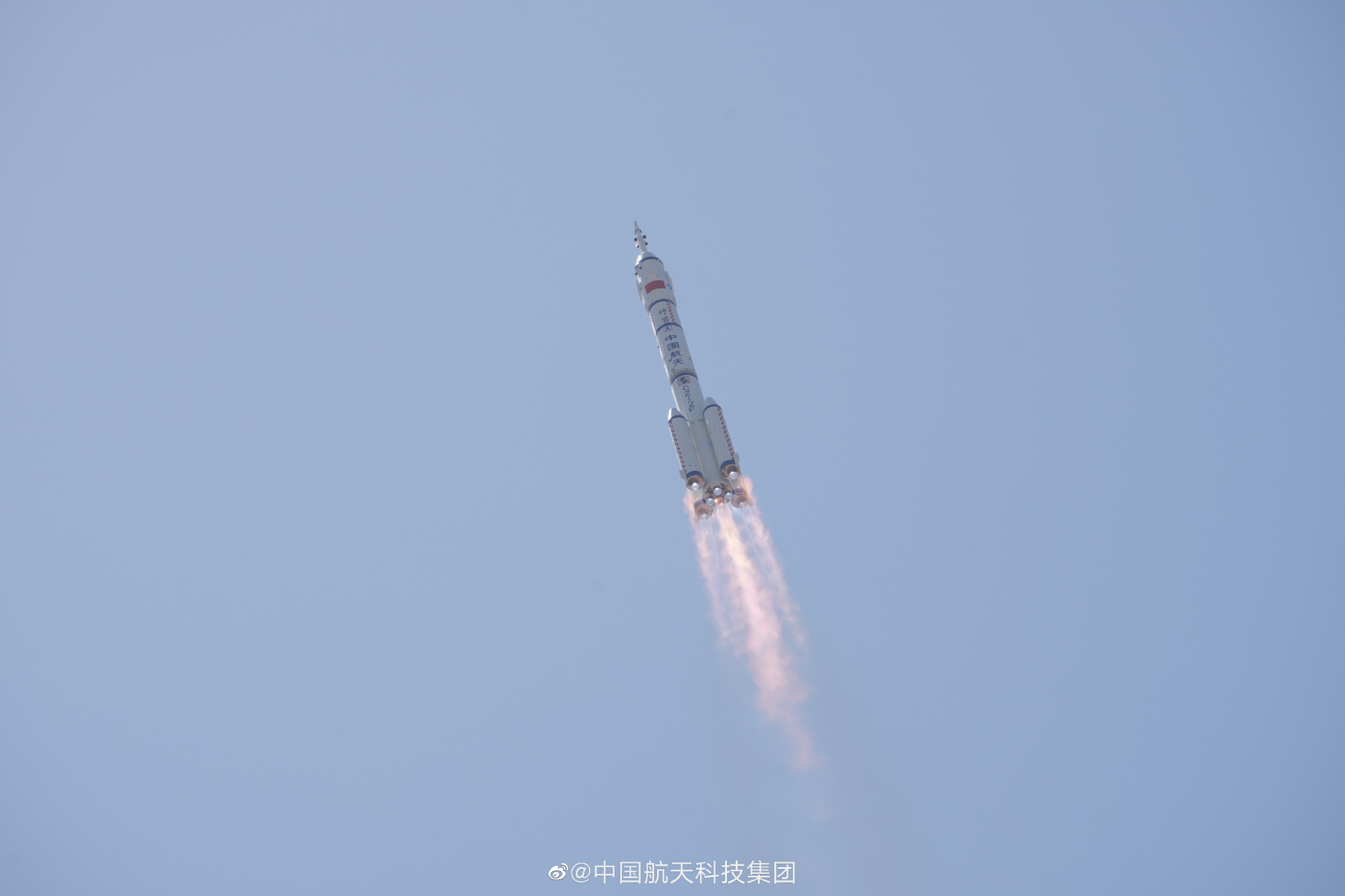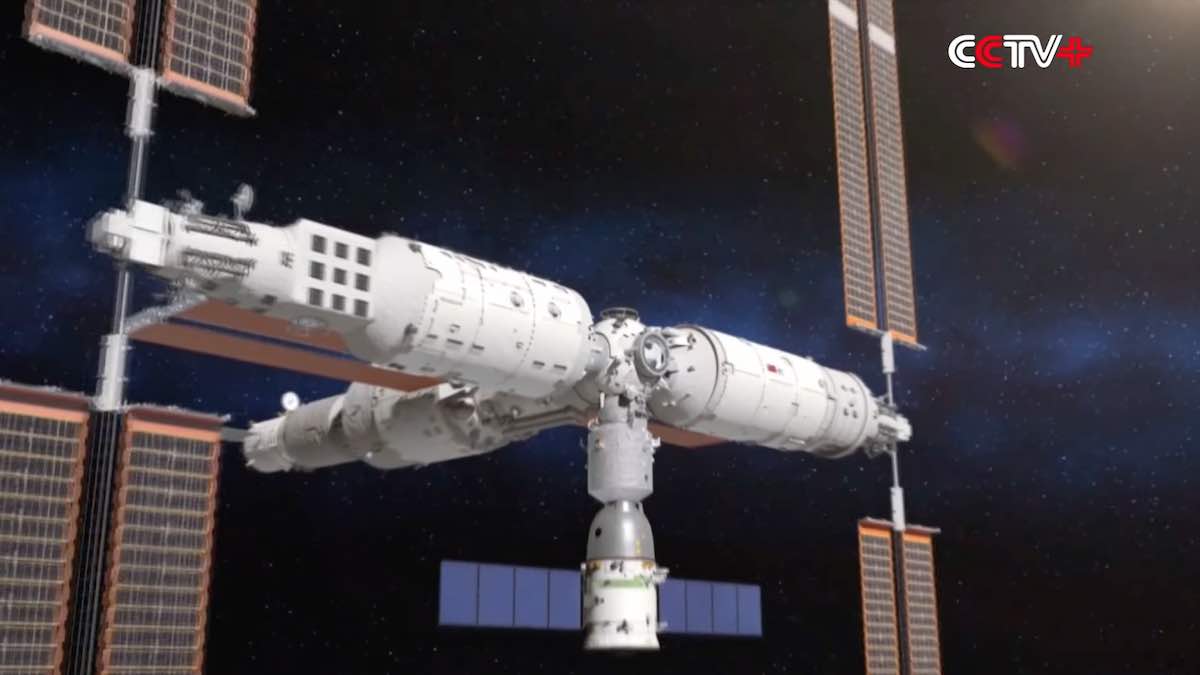
China’s Shenzhou 14 spacecraft glided to an automated docking at the Tiangong space station Sunday, hours after launching with three astronauts to begin a six-month mission that will see the outpost triple in size with the arrival of two new 20-ton research modules.
Commander Chen Dong monitored the Shenzhou 14 spacecraft’s on-board systems throughout the rendezvous and docking with the Tiangong space station. Chen is joined on the Shenzhou 14 mission by astronauts Liu Yang and Cai Xuzhe.
The trio linked up with the nadir, or Earth-facing port on the space station’s Tianhe core module at 5:42 a.m. EDT (0942 GMT) Saturday, according to the China Manned Space Agency.
The Shenzhou 14 astronauts planned to get out of their pressure suits, which they wore for launch and docking, and change into more comfortable flight suits before opening hatches to enter the Tianhe module.
The docking capped a seven-hour pursuit of the Tiangong space station that began with liftoff from the Jiuquan space base in northwestern China at 10:44:10 p.m. EDT (0244:10 GMT). A liquid-fueled Long March 2F rocket propelled the three-person crew into orbit in less than 10 minutes.
A core stage engine and four strap-on boosters generated 1.4 million pounds of thrust, driving the rocket and crew eastward from Jiuquan, taking aim on the Chinese space station. The Long March 2F consumed thousands of gallons of toxic, corrosive hydrazine and nitrogen tetroxide propellants to accelerate the 8.5-ton Shenzhou spaceship into orbit.
The second stage of the rocket deployed the crew craft about 10 minutes into the mission. Moments later, Shenzhou 14 unfurled its solar panels to begin producing its own electricity, and in-cabin cameras showed the astronauts in their seats getting acclimated to microgravity.
Liftoff of China’s Shenzhou 14 mission aboard a Long March 2F rocket, hauling a crew of three astronauts on a six-month mission to help construct the Tiangong space station. https://t.co/RpnyMUAEBO pic.twitter.com/AaFSB2P0W1
— Spaceflight Now (@SpaceflightNow) June 5, 2022
With its computer-controlled linkup with the Tianhe module, the Shenzhou 14 spacecraft joined China’s Tianzhou 3 and 4 supply ships docked at the Tiangong station, which which orbits Earth at an altitude of about 240 miles (385 kilometers). The most recent cargo delivery by the Tianzhou 4 spacecraft arrived May 9.
Shenzhou 14 is the third crew mission to visit the Chinese station. Shenzhou 12’s astronauts spent three months on the station last year, and the three astronauts on the Shenzhou 13 mission departed the orbiting complex April 15 to head for landing after six months in space.
During their planned half-year in orbit, the Shenzhou 14 astronauts will see the arrival of two new pressurized research modules that will link up with the Tianhe core section, giving the Chinese station its fully-assembled “T-shaped” configuration.
The astronauts will unpack equipment and supplies delivered by the Tianzhou 4 cargo freighter last month, and also see the arrival of the Tianzhou 5 supply ship later this year.
The Wentian module, set for launch in late July, will carry a small robotic arm designed for more precise movements than the larger arm positioned outside the Tianhe core module. The Wentian module will primarily host life science and biological experiments, Chinese officials said.
The launch of the Mengtian module is scheduled for October. It will accommodate materials science experiments and technology demonstrations, according to Lin, the deputy director for China’s human spaceflight program.

The heavy-lift Long March 5B launcher for the Wentian module arrived last month at the Wenchang launch base in southern China. The rocket components were manufactured at a state-run factory in Tianjin, China, and ferried to the launch base on Hainan Island by ship.
The Wentian lab itself was previously delivered to the launch site.
The Wentian and Mengtian modules will initially dock with an axial port on the Tianhe module. A mechanical arm will move the 20-ton modules to their final positions on each side of the space station’s core section.
The Shenzhou 14 astronauts will be the first to enter the Wentian and Mengtian modules after their final connection with the Tianhe core element. They will also use a new airlock in the Wentian module for two or three spacewalks, according to Lin.
For previous spacewalks outside the Chinese station, astronauts exited through a hatch on the Tianhe module.
“The flight crew of Shenzhou 14 will cooperate with the ground to complete the rendezvous, docking and repositioning of the two experimental cabins and the core cabin,” said Lin Xiqiang, deputy director of the China Manned Space Agency. “They will be stationed in the Wentian experimental cabin and the Mengtian experimental cabin for the first time to establish a manned environment.”
China’s Shenzhou 14 spacecraft has arrived in orbit after a successful launch aboard a Long March 2F rocket.
This marks the start of China’s ninth human spaceflight mission, carrying a crew of three to the Tiangong space station.https://t.co/RpnyMUAEBO pic.twitter.com/CwdQdsMnZo
— Spaceflight Now (@SpaceflightNow) June 5, 2022
The Shenzhou 14 crew will remain in orbit on the Chinese space station until December, when their replacements are scheduled to launch on the Shenzhou 15 mission.
The flight plan includes a brief handover between the Shenzhou 14 and 15 crews, temporarily raising the crew size on the Chinese space station to six astronauts, a record for China’s human spaceflight program.
With the arrivals and departures of cargo ships, the addition of two new research modules, spacecraft reposition maneuvers, and the docking of the Shenzhou 15 crew craft late this year, the Chinese space station will go through nine different configurations during the six-month Shenzhou 14 expedition.
The busy schedule will “put forward high requirements for the crew’s ability to perform,” Lin said.
Construction of the Tiangong space station began with the launch of the Tianhe core module in April 2021.
Chinese officials publicly revealed the crew of the Shenzhou 14 mission Saturday, less than 24 hours before the astronauts took off from the Jiuquan launch base.

Chen Dong is the commander of the mission. He is a 43-year-old former Chinese military fighter pilot who logged 32 days in orbit on the Shenzhou 11 mission in 2016. Joining him on the six-month Shenzhou 14 mission are Liu Yang and Cai Xuzhe, also pilots in the Chinese military.
Like Chen, Liu is making her second trip to space. She became the first Chinese woman to reach space in 2012 on the Shenzhou 9 mission. The 43-year-old is a colonel in the Chinese Air Force.
Cai, 46, launched into space for the first time.
“Besides work, I will also enjoy the beauty of space, take pictures of the beautiful Earth and the great motherland, take a look at the Yangtze River and the Yellow River, and find my dear hometown, and I will share it with you at that time,” Cai said in a pre-launch press briefing Saturday.
Email the author.
Follow Stephen Clark on Twitter: @StephenClark1.
from Spaceflight Now https://ift.tt/tNbemHo
via World Space Info







0 comments:
Post a Comment